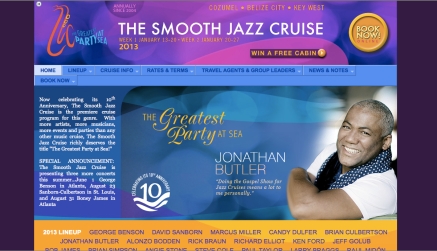“Easy listening,” “instrumental pop,” “lite jazz,” and “elevator music” are just a sampling of the ways in which “Smooth Jazz” is often classified. Smooth jazz typically features one primary lead instrument or vocal, accompanied by a standard pop arrangement. “Many songs are simple, and/or by-the-note, instrumental arrangements of pop songs.” The format tends to fit radio programming nicely, in that, most songs fall under the 4-minute mark in length. This comes as no surprise considering the format is said to have been created by radio itself.
“Smooth jazz, was literally created by radio. Indeed, the birth of the term is said to have happened during a focus group held in Chicago, as a marketing research group sought to find the right label to sell a new brand of easy-listening music being played on radio in the ’70s. Thus, smooth jazz is more of a format or branding device than as an actual organic musical style. And smooth jazz artists have long been seen as joined at the hip to the stations that play their music.” – Jim Harrington, The Oakland Tribune.
Because of its inception in broadcast radio during the early ’80s, major labels began signing smooth jazz artists in an attempt to profit off of the new mainstream radio format. In recent years, however, the smooth jazz format is widely being replaced with more appealing radio formats, like classic rock and R&B. Despite this shift in programming, a number of independent labels are finding success with their roster of smooth jazz artists.
Rendezvous Entertainment
In 2002, during the peak of the smooth jazz radio format, multiple Grammy nominee and RIAA certified Gold smooth jazz recording artist, Dave Koz teamed up with radio executive Frank Cody, referred to as “The Father of Smooth Jazz” by the New York Times for his work in programming one of the first successful smooth jazz radio stations in Los Angeles, and record industry veteran Hyman Katz to create a new independent label called Rendezvous Entertainment. This new label featured a number of smooth jazz “all-stars” like Marc Antoine and Michael Lington. What’s interesting, nonetheless, is that the new label’s owner, Dave Koz, was under contract with Captiol Records during his entire stint with Rendezvous. 
Despite the creation of an independent label featuring many of the biggest names in a thriving niche genre, many of whom had just left major label contracts, this new record label did not receive a great deal of press at the time of its founding. Additionally, two of the three owners had the benefit of working directly in smooth jazz radio to provide their artists an edge. Much to the author of this blog’s surprise, this was never heavily covered in any of the major music publications or media outlets at the time. Approximately 10 years earlier in 1994, just as his solo career was taking off, Dave Koz began hosting a syndicated radio program called “The Dave Koz Radio Show.” The show featured music and interviews by artists in the smooth jazz genre – a direct stage for Koz and co. to present Rendezvous artists and their music. Frank Cody continued to work as a radio programming consultant for many of the popular smooth jazz radio stations – another direct outlet for Rendezvous artists.
As the decade wore on, the 2000s saw the rise of Rendezvous Entertainment artists like Wayman Tisdale, the former NBA All-Star turned professional musician, and Kirk Whalum, who gained early career fame and success working with artists such as Whitney Houston. (Whalum’s iconic saxophone solo can be heard in the chart-topping hit, “I Will Always Love You,” from The Bodyguard Soundtrack).

The 2000s also saw the creation of a new type of luxury entertainment: The Smooth Jazz Cruise. This 7-day vacation was the marriage of Holland America cruise lines with performances by the who’s who in the smooth jazz world featuring several of the Rendezvous Entertainment artists on the main stage of the maiden voyage. Rendezvous quickly discovered that not only did the annual cruises help to generate more exposure, and in turn more CD sales for their artists; they learned that it provided a way for their artists to connect more closely and directly with their fans.
Mack Avenue Records Merger and Acquisition
Detroit, MI has been home to some of the most influential artists and independent labels in the history of recorded music. It is no surprise that another influential force in the smooth jazz world would hail from this locale. In 1999, Gretchen Valade and Tom Robinson formed the contemporary jazz label Mack Avenue Records, Inc.  with a focus on highlighting the budding contemporary jazz scene in Detroit as well as releasing great music to the general public. The rise of Rendezvous Entertainment coincided with the growth of another independent contemporary jazz and R&B label called Artistry Music, featuring legendary artists such as Brian Bromberg and Rahsaan Patterson. Mack Avenue Records purchased Artistry Music in 2004, combining and expanding the growing Mack Avenue roster. Then in 2008, Mack Avenue solidified its footing in the smooth jazz world by acquiring Artizen Music, an independently owned smooth jazz label featuring world-renowned artists Rick Braun and Richard Elliot. Mack Avenue quickly rolled Artizen Music under the Artistry label imprint. Then later in 2008, Mack Avenue once again increased its standing in the smooth jazz industry by purchasing Rendezvous Entertainment. They quickly changed the name to Rendezvous Music, and continued to promote the great music being created by their newly acquired artists.
with a focus on highlighting the budding contemporary jazz scene in Detroit as well as releasing great music to the general public. The rise of Rendezvous Entertainment coincided with the growth of another independent contemporary jazz and R&B label called Artistry Music, featuring legendary artists such as Brian Bromberg and Rahsaan Patterson. Mack Avenue Records purchased Artistry Music in 2004, combining and expanding the growing Mack Avenue roster. Then in 2008, Mack Avenue solidified its footing in the smooth jazz world by acquiring Artizen Music, an independently owned smooth jazz label featuring world-renowned artists Rick Braun and Richard Elliot. Mack Avenue quickly rolled Artizen Music under the Artistry label imprint. Then later in 2008, Mack Avenue once again increased its standing in the smooth jazz industry by purchasing Rendezvous Entertainment. They quickly changed the name to Rendezvous Music, and continued to promote the great music being created by their newly acquired artists.
Since the merger with Mack Avenue Records, Rendezvous Music has experienced both major growth and tragic loss. Rendezvous Music recently signed jazz artist Kyle Eastwood, son of Hollywood icon Clint Eastwood, to handle his distribution in the United States as Eastwood is signed to an independent label in the UK called, “Candid.” 2009 witnessed the tragic loss of Rendezvous Music recording artist Wayman Tisdale, losing his 2-year battle to cancer. The death of Tisdale sent shock waves throughout both the sports and music worlds inspiring a documentary called “The Wayman Tisdale Story” alongside a tribute song by Wayman’s friend and collaborator Toby Keith, featuring Rendezvous Music founder Dave Koz and jazz legend Marcus Miller.

Rendezvous Music and Mack Avenue Records have determined a foolproof recipe for success:
- Sign already established artists to record deals – Every artist on Rendezvous’s roster, except one, had a major label deal at one point or another throughout his career. (Brian Simpson was the only artist who did not have any previous ties with a major label listed on his website. Despite these shortcomings, he has been able to get global exposure for his solo career serving as Dave Koz’s band director for the past several years.)
- Keep the size of the roster manageable – Rendezvous’s roster has never exceeded more than 7 artists at any one time in its short lifespan. This has allowed the label to maintain its reach while developing artists’ careers in the process.
- Make good music – Despite what the critics say, there has been a great deal of development in the contemporary jazz genre over the past several years as well as influence on other genres directly because of smooth jazz artists. A number of artists on Rendezvous are continually nominated for Grammy awards each year. (Kirk Whalum won the 2011 Grammy award for Best Gospel Song, “It’s What I Do”-featuring Lalah Hathaway)
- Create and maintain strategic partnerships in multiple areas of the recording industry – It is no surprise that Rendezvous artists have done quite well in terms of radio airplay over the past decade. Obviously, they had some corner on the market with Frank Cody and Dave Koz serving as gatekeepers to the rest of the industry; nonetheless, both Cody and Koz took the necessary steps to hold their positions in an area of influence giving their artists a better chance of success.
- Build unique and meaningful connections with fans – Rendezvous artists have been at the forefront of marketing the musical experience as much as the musical product. One factor that does not get mentioned as often in terms of record labels is the fact that every single one of the Rendezvous artists is a natural performer. Their live shows are fun, coaxing the most stubborn of listeners to tap his foot and get up and dance. With events like the Smooth Jazz Cruise and performances at Wine Vineyards throughout California, Rendezvous Music has discovered ways to market their music to the moment and not to the product.
The Future of Rendezvous Music
There have been several predictions in the past couple of years that as smooth jazz radio dies out, so will the genre itself. What seems to be most interesting about Rendezvous music and other independent smooth jazz labels is that they were created in exactly the opposite manner that most independents are created. The smooth jazz artists started out at the major labels with a radio format already in place to launch their careers. As the smooth jazz radio format began to really hit its peak, many of the prominent artists began seeking out independent label contracts, not major label deals. As the indie labels began to gain prominence, the focus on radio airplay began to dwindle. Now that we are almost a quarter of the way through the 2010s, most major cities have changed their smooth jazz radio programming formats in attempts to reach broader audiences. As these formats fade out, it is imperative that independent smooth jazz labels, like Rendezvous and Mack Avenue, continue to develop new and unique methods of reaching and connecting with an aging fan base. Additionally, focusing on creating groundbreaking and limit pushing music, as opposed to making “commercial” music, will aid in the prosperity of the labels and more importantly the genre as a whole. There will always be critics. With genuine creation and a desire to entertain, there will always be that next, young fan waiting to be inspired.
Written by Matt Leigh
Matt is a Master of Fine Arts student in the Recording Arts and Technologies program at Middle Tennessee State University
Sources:
http://www.mackavenue.com/rendezvous_music
http://frankcody.com/Home.html
http://davekoz.com/
http://www.mackavenue.com/
http://en.wikipedia.org/wiki/Mack_Avenue_Records
http://kirkwhalum.com/index2.php#about.php
http://www.mackavenue.com/artists/detail/wayman_tisdale
http://en.wikipedia.org/wiki/Wayman_Tisdale
http://www.jonathanbutler.com/bio
http://www.bsimpsonmusic.com/
http://kyleeastwood.com/biography/
http://www.allaboutjazz.com/php/musician.php?id=6469
http://www.davekoz.com/radio/about.php
http://www.thesmoothjazzcruise.com/2013/Home
http://www.nytimes.com/1997/06/05/arts/radio-stations-enjoy-rising-ratings-as-music-purists-fume.html?pagewanted=all&src=pm
Harrington, Jim. “Smooth Jazz Might be in Big Trouble.” The Oakland Tribune, June 11, 2009.
